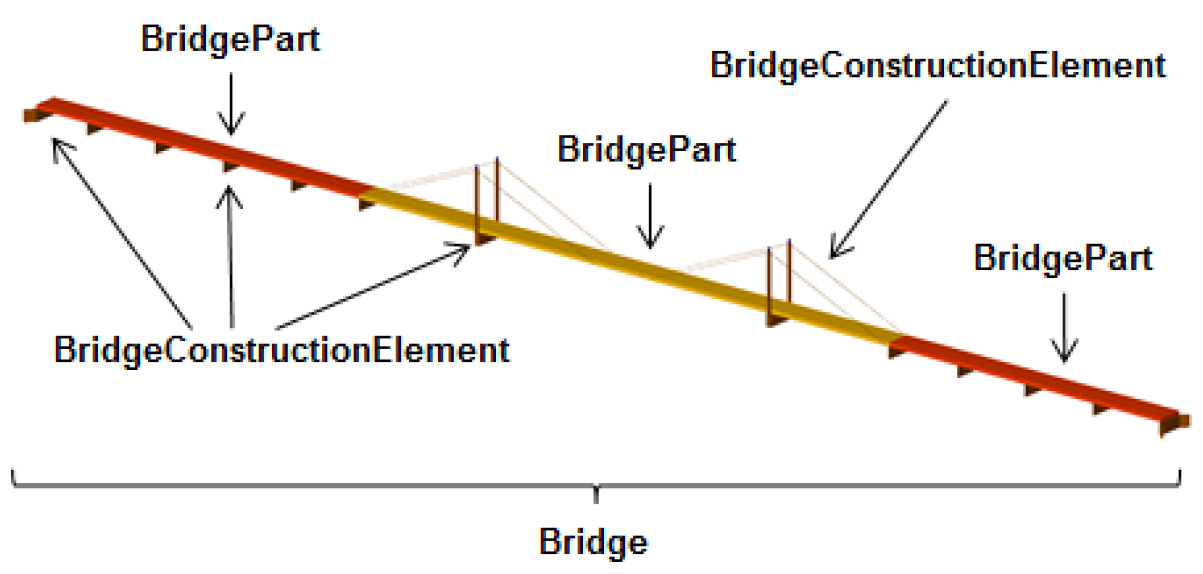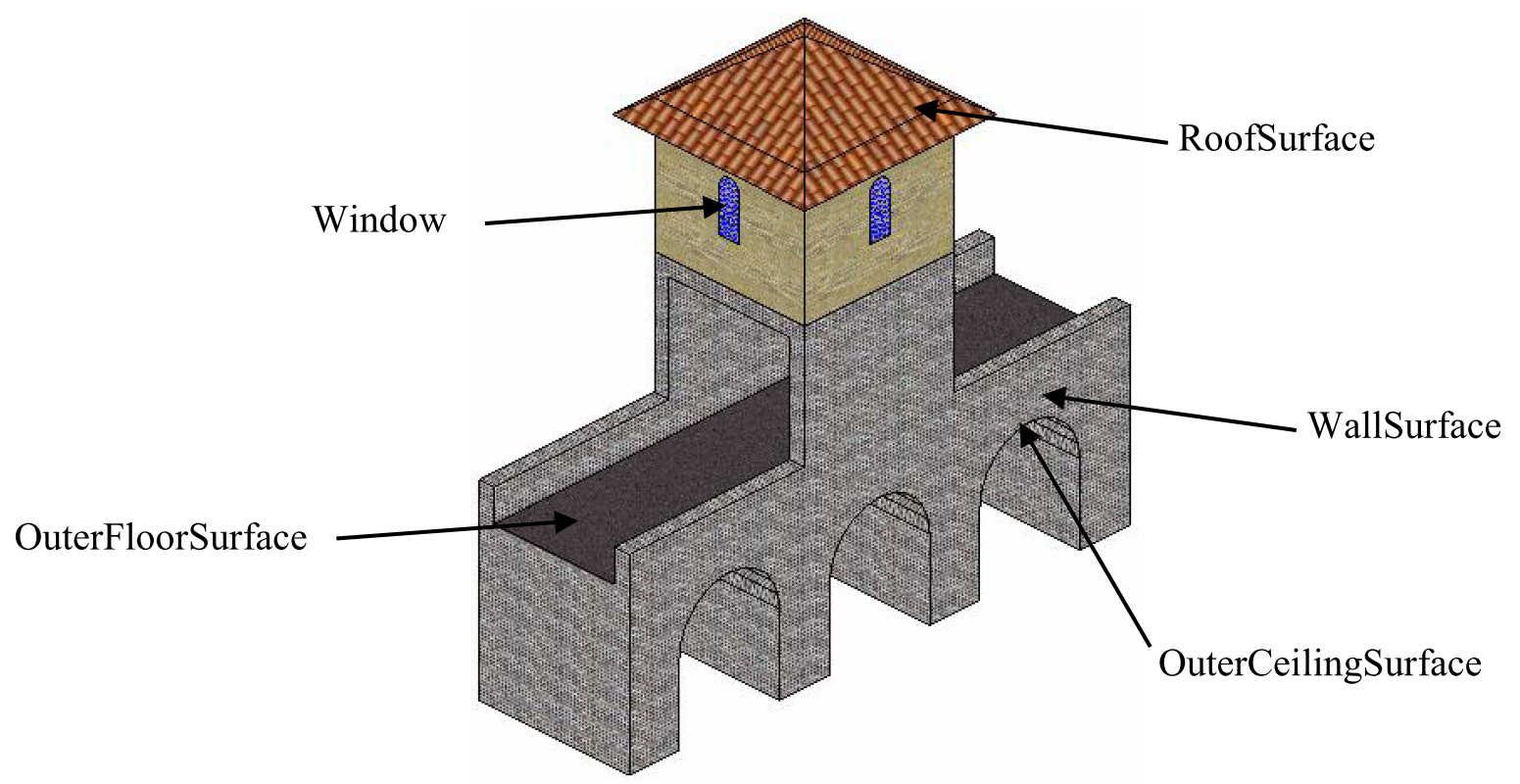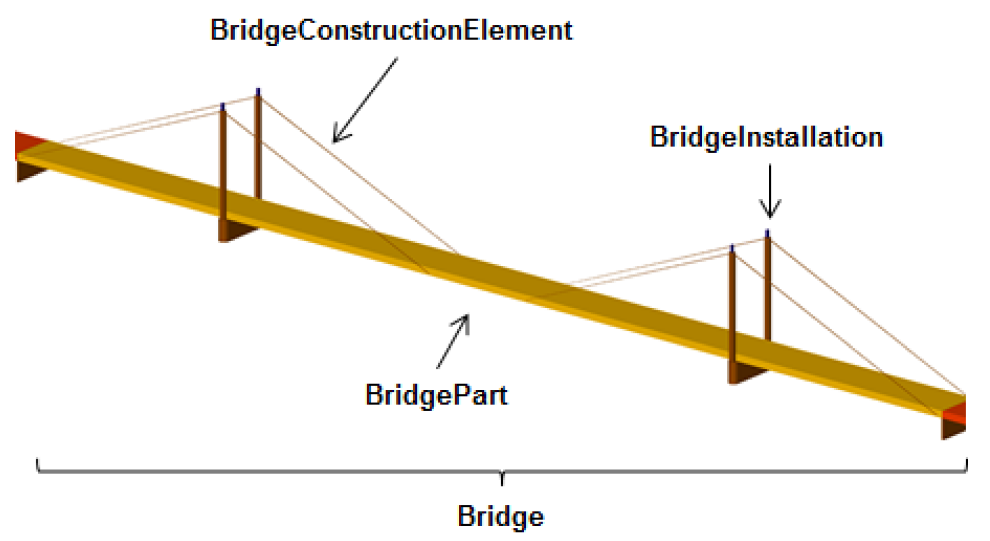3.1.6. Bridge model¶
The bridge model was developed in analogy to the building model (cf. Section 3.1.5) with regard to structure and attributes [GKCN2008]. The bridge model allows for the representation of the thematic, spatial and visual aspects of bridges and bridge parts in four levels of detail, LOD 1 – 4. A (movable or unmovable) bridge can consist of multiple BridgeParts. Like Bridge, BridgePart is a subclass of _AbstractBridge and hence, has the same attributes and relations. The relation consistOfBridgePart represents the aggregation hierarchy between a Bridge (or a BridgePart) and it’s BridgeParts. By this means, an aggregation hierarchy of arbitrary depth can be modelled. The semantic attributes of an _AbstractBridge are class, function, usage and is_movable. The attribute class is used to classify bridges, e.g. to distinguish different construction types (cf. Fig. 3.9). The attribute function allows representing the utilization of the bridge independently of the construction. Possible values may be railway bridge, roadway bridge, pedestrian bridge, aqueduct, etc. The option to denote a usage which is divergent to one of the primary functions of the bridge (function) is given by the attribute usage. Each Bridge or BridgePart feature may be assigned zero or more addresses using the address property.

Fig. 3.9 Example of bridge consisting of bridge parts
The spatial properties are defined by a solid for each of the four LODs (relations lod1Solid to lod4Solid). In analogy to the building model, the semantical as well as the geometrical richness increases from LOD1 (blocks model) to LOD3 (architectural model). Interior structures like rooms are dedicated to LOD4. To cover the case of bridge models where the topology does not satisfy the properties of a solid (essentially water tightness), a multi-surface representation is allowed (lod1MultiSurface to lod4MultiSurface). The line where the bridge touches the terrain surface is represented by a terrain intersection curve, which is provided for each LOD (relations lod1TerrainIntersection to lod4TerrainIntersection). In addition to the solid representation of a bridge, linear characteristics like ropes or antennas can be specified geometrically by the lod1MultiCurve to lod4MultiCurve relations.
The thematic boundary surfaces of a bridge are defined in analogy to the building module. _BoundarySurface is the abstract base class for several thematic classes, structuring the exterior shell of a bridge as well as the visible surfaces of rooms, bridge construction elements and both outer and interior bridge installations. From _BoundarySurface, the thematic classes RoofSurface, WallSurface, GroundSurface, OuterCeilingSurface, OuterFloorSurface, ClosureSurface, FloorSurface, InteriorWallSurface, and CeilingSurface are derived.

Fig. 3.10 Different BoundarySurfaces of a bridge
Bridge elements which do not have the size, significance or meaning of a BridgePart can be modelled either as BridgeConstructionElement or as BridgeInstallation. Elements which are essential from a structural point of view are modelled as BridgeConstructionElement, for example structural elements like pylons, anchorages etc. (cf. Fig. 3.9 and Fig. 3.11). A general classification as well as the intended and actual function of the construction element are represented by the attributes class, function, and usage. The visible surfaces of a bridge construction element can be semantically classified using the concept of boundary surfaces representing floor (FloorSurface), ceiling (CeilingSurface), and interior walls (InteriorWallSurface) (cf. Fig. 3.10). Whereas a BridgeConstructionElement has structural relevance, a BridgeInstallation represents an element of the bridge which can be eliminated without collapsing of the bridge (e.g. stairway, antenna, and railing) (cf. Fig. 3.11). BridgeInstallations occur in LOD 2 to 4. The class BridgeInstallation contains the semantic attributes class, function and usage. The attribute class gives a classification of installations of a bridge. With the attributes function and usage, nominal and real functions of the bridge installation can be described.

Fig. 3.11 Example of bridge consisting of BridgeConstructionElement and BridgeInstallation
In LOD3 and LOD4, a _BoundarySurface may contain _Openings like doors and windows. The classes BridgeRoom, IntBridgeInstallation and BridgeFurniture allow for the representation of the bridge interior. They are designed in analogy to the classes Room, IntBuildingInstallation and BuildingFurniture of the building module and share the same meaning. The bridge interior can only be modelled in LOD4.

Fig. 3.12 UML diagram of bridge model